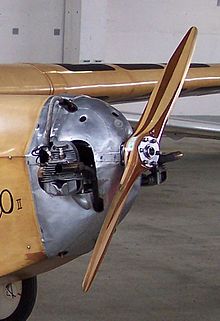Bristol Cherub

The Bristol Cherub was an aircraft engine made by the British manufacturer Bristol . It is an air-cooled two-cylinder boxer engine . This engine was relatively widespread from its introduction in 1923 until the mid-1930s. It was also used in Germany on the Messerschmitt M17 .
Versions
There were three series of this engine:
Cherub I.
The Cherub I was introduced in 1923 and produced until 1927. The engine weighed 41 kg, made 25 horsepower at 2500 min -1 and had only an ignition system. The bore was 85 mm and the stroke 96.5 mm, which resulted in a displacement of 1095 cm³. The best-known machine in which this engine was used was probably the Avro 562 . The engine was also used in a few other machines, such as the Bristol Type 91 or the Short S.4 Satellite.
Cherub ii
The Cherub II corresponded to the Cherub I, but had a reduction gear of I = 2, which made it possible to increase the engine speed for more power and at the same time to lower the propeller speed . The engine delivered 34 horsepower at 4000 min -1 and weighed 49 kg. It was also used in the Avro 562 and the Short S.4. The engine didn't have the best reputation and was considered vulnerable.
Cherub III
The Cherub III was the most successful type. To increase performance, the engine was bored out to 90 mm, which resulted in a displacement of 1228 cm³. The engine, introduced in 1925, was manufactured with two spark plugs per combustion chamber from the outset, and later it was also equipped with a real double ignition. He made 32 horsepower at 2900 min -1 , the starting power was 36 hp at 3200 min -1 . His weight was 45 kg. In addition to the Messerschmitt, the engine was installed in the Mignet HM-14 , Bristol Type 91, De Havilland DH.53 Hummingbird , Hawker Cygnet and many other small aircraft.